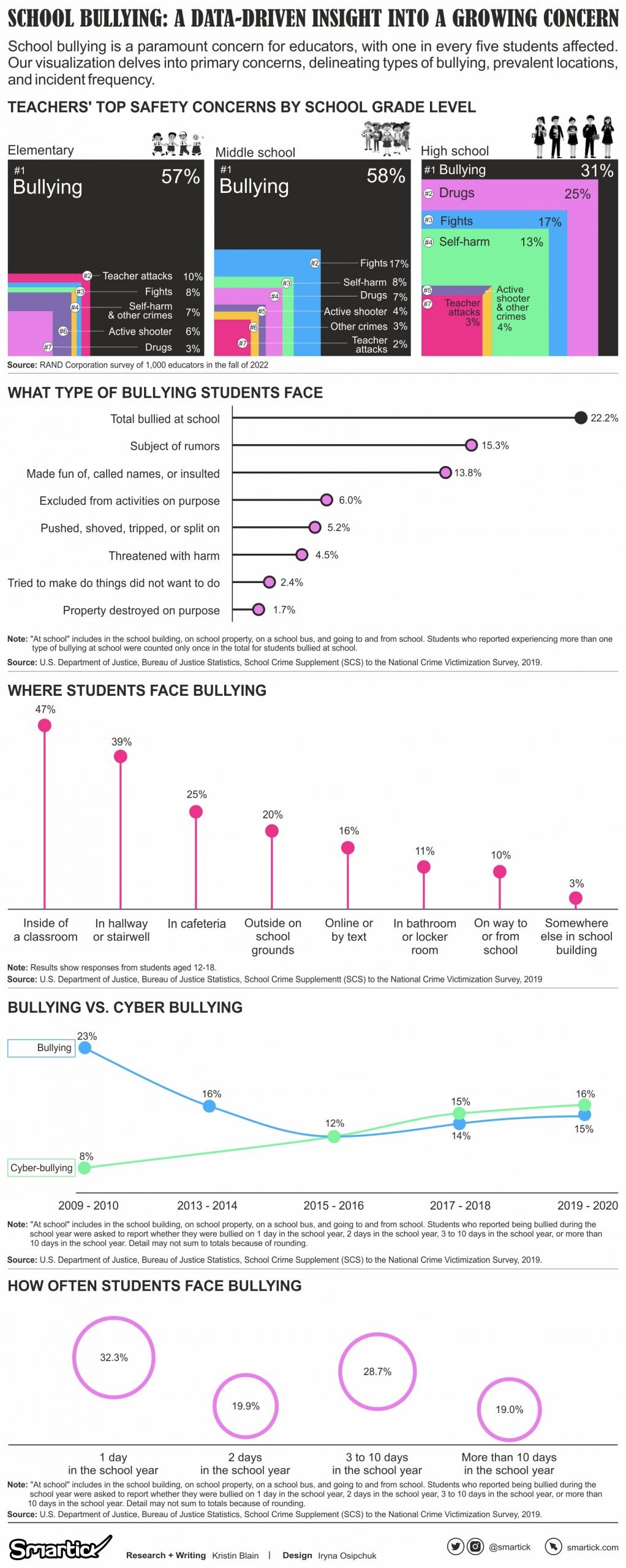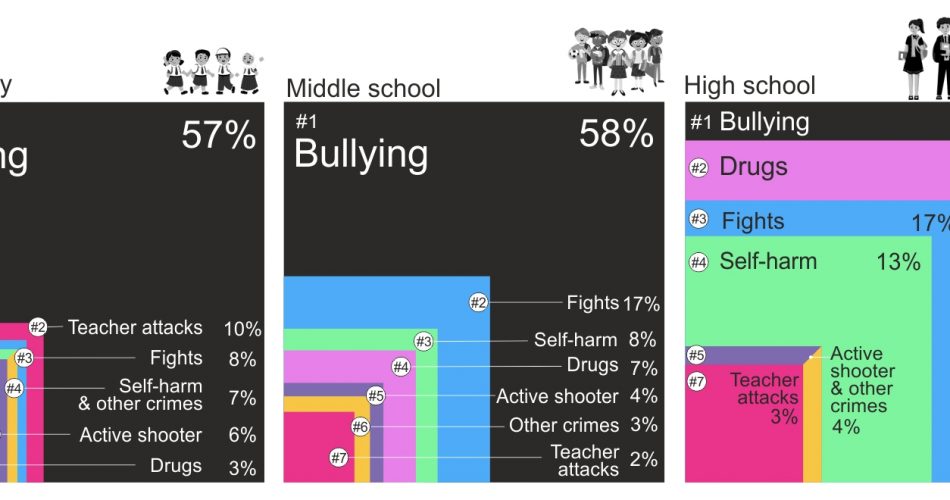
Bullying has risen as a pressing concern in education. A 2022 Pew Research survey found 75% of parents worried about their child being bullied. Academically, bullied students underperform and disengage, with a study showing effects from kindergarten to 12th grade. Additionally, 20% of high schoolers reported being bullied, as per the U.S. Centers for Disease Control and Prevention.

Teachers’ Top Safety Concerns by School Grade Level
While the discourse around school safety often revolves around extreme cases like school shootings, teachers perceive a different primary threat: bullying. According to a report from the RAND Corporation, bullying outranks even school shootings or the presence of drugs on campus as a safety concern among educators. Interestingly, despite a slight decline in bullying incidents since 2009 as recorded by federal data, the perception of its prevalence remains strong among teachers.
Breaking down teachers’ concerns by numbers:
- Bullying and cyberbullying: Nearly half of all educators, at 49%, recognized bullying as their paramount safety concern. This concern was consistent across grade levels but was particularly emphasized in elementary and middle schools, with 57% and 58% of teachers respectively citing it as a primary concern. In contrast, only 31% of high school teachers felt the same.
- School Shootings: Despite their tragic nature and the media attention they garner, only 5% of teachers overall identified active shootings as their leading worry.
- Other Concerns by Grade:
- High School: Drugs (25%) and student fights (17%).
- Middle School: Fights and students’ self-harm.
- Elementary School: Violence against teachers was a notable concern.
What Type of Bullying Students Face
Bullying is a multifaceted issue, taking on various forms that range from verbal taunts to more overt physical actions. Analyzing the experiences of students aged 12–18 provides insights into the most common types of bullying behaviors they encounter:
- Predominant Bullying Forms: Nearly a quarter (22.2%) of students reported being bullied at school. Among these, the most common forms of bullying involved being the subject of rumors (15.3%) or being made fun of, called names, or insulted (13.8%).
- Exclusion and Physical Aggression: A significant number, 6% of students, mentioned they were deliberately excluded from activities. Additionally, 5.2% recounted incidents where they were physically harassed – pushed, shoved, tripped, or even spit on.
- Threats and Coercion: A concerning 4.5% of students shared experiences of being threatened with harm. Another 2.4% mentioned instances where they were coerced into actions they were uncomfortable with.
- Damage to Personal Property: While it represents a smaller percentage (1.7%), the intentional destruction of students’ property is another manifestation of bullying that some students faced.
While each form of bullying has its unique implications, the collective data underscores the urgent need for multifaceted interventions in schools.
Where Students Face Bullying
Understanding where bullying takes place is crucial for implementing effective interventions. Here are the highlights of the locations where students aged 12–18 reported experiencing bullying during the 2019 school year:
- Predominant Locations: Almost half (47%) of the students who reported being bullied indicated that it occurred inside the classroom. Close behind, 39% experienced bullying in the hallway or stairwell. The cafeteria was another prominent location, with 26% of students identifying it as a site of bullying incidents.
- Outdoor and Commute-Related Locations: Bullying isn’t confined within school walls. About 20% of students reported being bullied outside on school grounds, and 10% experienced such incidents on their way to or from school.
- Online Bullying: The digital realm isn’t immune to bullying. In fact, 16% of students mentioned they were bullied online or via text messages, highlighting the growing concern of cyberbullying.
- Other Locations: More private locations like bathrooms or locker rooms saw 11% of students experiencing bullying. Additionally, 3% of students reported bullying incidents occurring in other areas within the school building.
The data underscores that bullying can occur almost anywhere within or around the school environment and even extends into students’ digital lives. It’s worth noting that these experiences were relatively consistent across various student and school demographics, suggesting that bullying is a pervasive issue irrespective of specific characteristics.
Bullying vs. Cyberbullying: Shifting Trends
Over the past decade, there’s been a significant shift in the landscape of bullying. Both traditional bullying and cyberbullying have seen changing trends that reveal the evolving nature of student interactions and challenges:
- 2009-10: Traditional bullying was at its peak with 23% of students reporting incidents. Cyberbullying, still relatively new, affected 8% of students.
- 2013-14: Bullying saw a decline, with reports dropping to 16%, while there was no recorded change in cyberbullying from the previous measurement.
- 2015-16: Traditional bullying continued its descent to 12%. Interestingly, this year marked a rise in cyberbullying, which jumped to 12%, mirroring the traditional bullying rate for the first time.
- 2017-18: Both forms of bullying witnessed an increase. Traditional bullying edged up to 14%, and cyberbullying surpassed it at 15%.
- 2019-20: Traditional bullying saw a slight increment, standing at 15%. Cyberbullying, however, continued its upward trajectory, reaching 16%.
The data underscores a notable transition over the years. While traditional bullying has shown an overall decline, cyberbullying is on an upward trend. By the latter half of the decade, cyberbullying rates began to mirror, and then surpass, those of its traditional counterpart. This shift emphasizes the growing influence of digital platforms in students’ lives and highlights the increasing importance of addressing bullying both in physical and digital domains.
How Often Students Face Bullying
In 2019, the prevalence of bullying continued to be a pressing concern. A notable 32% of students reported experiencing bullying just once during the year, while another 20% were bullied on two occasions. Alarmingly, a significant 19% revealed that they faced bullying over ten times throughout the year, especially prevalent among those beyond the 6th grade. The silver lining to this issue was the proactiveness in reporting; nearly half of the students, or 46%, came forward to notify an adult about their experiences. Especially commendable was the tendency of Black students and those in younger grades to be more forthcoming about these distressing incidents.
Bullying remains a pervasive issue in schools, affecting both the well-being of students and the overall learning environment. The recent data underscores not only the frequency of these incidents but also the evolving nature of bullying, especially with the rise of cyberbullying. However, the increasing willingness of students, particularly among specific demographics, to report incidents to authorities offers a glimmer of hope. It underscores the importance of continuing education and intervention strategies in schools, as well as fostering a culture of open dialogue and support, ensuring that every student feels safe and valued.

